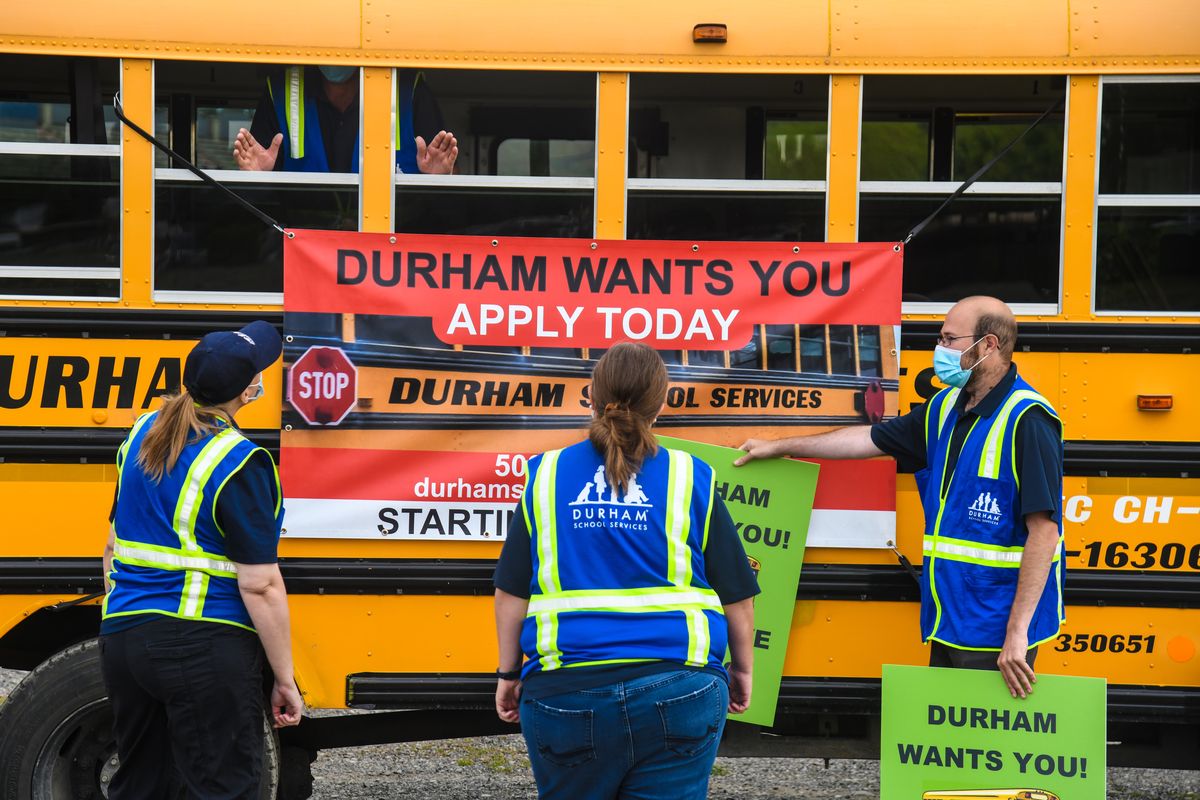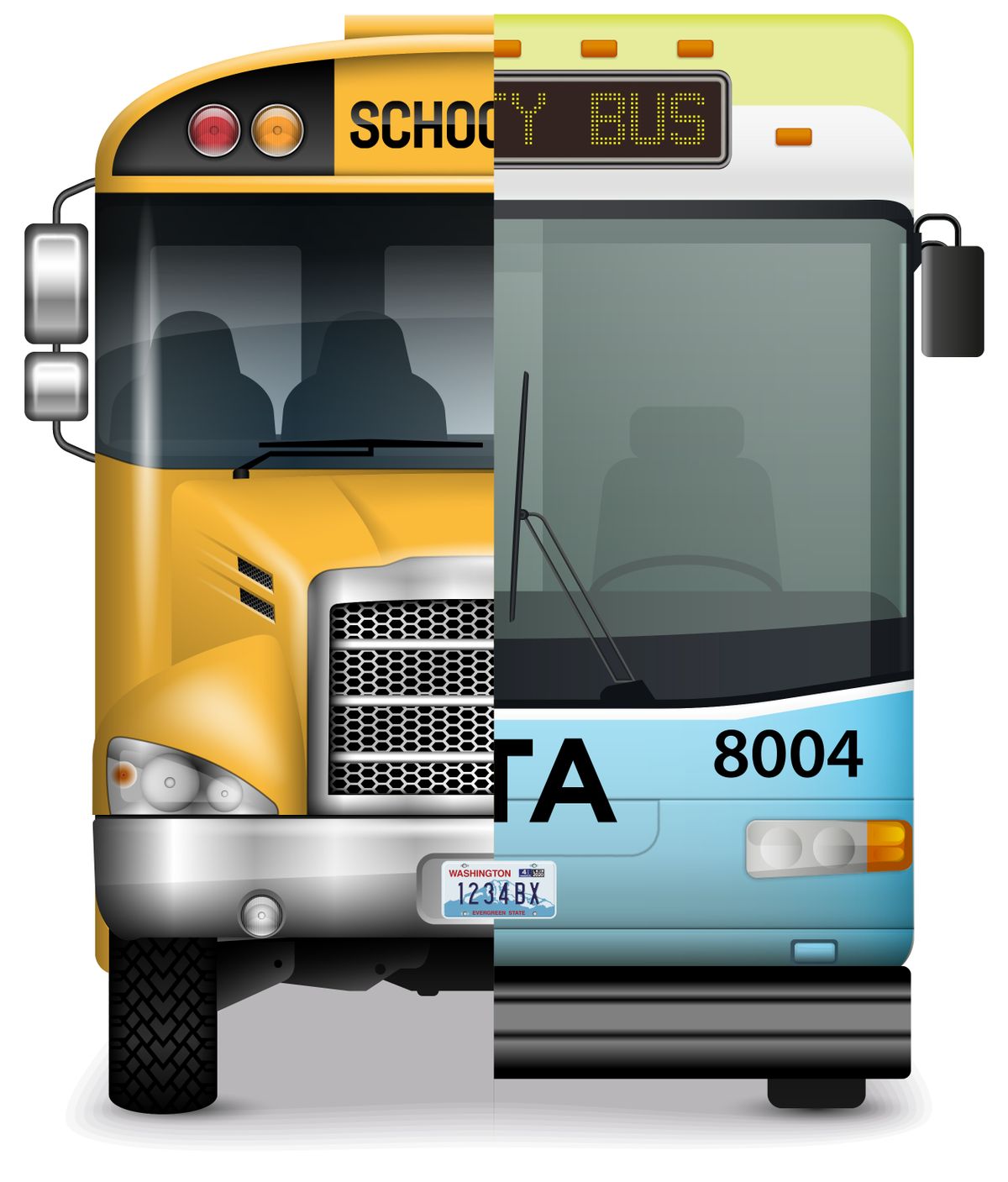This column reflects the opinion of the writer. Learn about the differences between a news story and an opinion column.
Getting There: Bus driver shortages are keeping Spokane students from school. Can STA help?
Durham School Services drivers hang a ‘help wanted’ sign on a bus at Joe Albi Stadium on July 23, 2020. (DAN PELLE/THE SPOKESMAN-REVIEW)Buy a print of this photo
If you have a child in Spokane Public Schools, the texts and emails are familiar by now, just two weeks into the new school year.
“Bus 114 & 159 busing students, running late. You are welcome to pick up your student.”
“Parents of bus riders at 4th & Hemlock. The bus missed your students’ pick-up and another bus is being routed to pick them up.”
“Parents of bus 126: delayed 1 hour every Tuesday AM pick up for 6 weeks. You are welcome to bring your child to school.”
“Due to driver shortage, Bus 159 riders will be picked up on Fridays 70 minutes past their normal pick up time, and will leave Roosevelt Friday afternoons at 4:15. This will occur for the next 6 weeks.”
“Durham is looking for substitute and permanent drivers. Please visit Durham School Services if you are interested.”
Spokane Public Schools contracts with Durham to bus about 7,000 students a day on 105 routes.
That’s obviously a complex undertaking – and one that has been massively complicated by COVID-19.
Some potential drivers are skittish about exposure, and others are skittish about getting the most effective means of protecting themselves against such exposure, a vaccine.
At least that’s what Chris Carey, who manages Durham’s operations in the Pacific Northwest and Alaska, told The Spokesman-Review earlier this month.
Those factors contributed to and exacerbated a more general problem: the pandemic’s broad, nationwide upending of the labor market, which has left a wide range of employers scrambling to fill their open positions.
In an effort to attract more applicants, Durham raised its wages to a starting rate of $18.90 an hour, plus a $4,000 signing bonus for prospects who already have a commercial driver’s license or $2,000 for those without that license.
But even that hasn’t been enough to keep enough drivers behind the wheels of Spokane’s school buses.
Some cities facing the same problem have gone to drastic lengths to fill the gap.
Boston and Baltimore called out the National Guard to help.
Meanwhile, the Spokane district has been considering a seemingly more commonsense solution: enlisting the city’s existing public bus service, which the Spokane Transit Authority operates.
Brandon Rapez-Betty, STA’s director of communications and customer service, said officials from Spokane Public Schools reached out about a month ago to begin “exploring creative solutions to the district’s shortage of drivers.”
While Rapez-Betty said STA is eager to answer the call, STA’s ability to do so is constrained by Federal Transit Administration regulations that seek to “protect private charter operators from unauthorized competition from FTA grant recipients,” including STA, according to the administration’s website.
“In essence, the charter regulations were implemented to ensure that transit agencies, subsidized with federal money, do not unfairly compete with privately owned bus companies. Under the charter rules, with limited exceptions, local transit agencies are restricted from operating chartered services,” the FTA site states.
That rule, plus others that exclude school bus service from the services public transportation agencies can offer, may protect Durham, but it is harming students and their parents.
Because of those federal rules, Spokane Public Schools can’t simply pay STA to use excess buses and drivers to fill in the gaps and drive the routes that Durham can’t cover as it usually would.
That doesn’t mean, however, that STA can’t pitch in at all.
“Keeping that regulation in mind,” Rapez-Betty said, “what can we do?”
One possibility that SPS has considered, he said, is trying to create “school pools” that would involve “trying to organize” families in certain areas and find ways “to get (kids) to school” using private vehicles, much like a carpool allows people to work together to get to work.
STA hosts the county’s Commute Finder NW website, which helps grown-ups do just that: find carpools as well as organize with slightly larger groups to create a “vanpool” that uses an STA van instead of a personal vehicle.
While Rapez-Betty said “no decisions were ever made” about whether Spokane Public Schools would actually try to use this existing tool for a new purpose, he also said STA remains open to the idea.
Meanwhile, though, Rapez-Betty said more serious conversations are underway about boosting student use of STA’s existing fixed-route service to get kids to and from school.
He said every high school and middle school except Chase Middle School “have transit within a couple blocks” and that STA buses could be a “turnkey solution” for some families affected by this school year’s unusual interruptions in regular service.
Rapez-Betty also noted that the “school district has bought passes from STA for years now” to subsidize a limited amount of transit for students, such as for those participating in the Choice program that lets kids attend a school other than their assigned, neighborhood school.
If more students switched to fixed route STA buses from their usual Durham routes, Rapez-Betty said his agency would consider adding “tripper” buses, which dispatchers can deploy when demand exceeds available space on a coach.
If STA knew “a large group of students are getting on a bus on at a certain time,” like after the final bell of the school day, for example, Rapez-Betty said STA could consider sending such a tripper for the overflow, depending “on the resources available at the specific time.”
While he was reluctant to “get too specific with potential solutions,” he said that kind of accommodation of student demand for existing city bus service is “the kind of solution that we would explore.”
But despite “a lot of ideas and brainstorming,” Rapez-Betty said, “we’ve not landed on any specific solutions.”
As for how seriously Spokane Public Schools is pursuing such solutions, that’s unclear.
When asked about partnering with STA to deal with the deficiencies, Sandra Jarrard, the district’s executive director of communications and government affairs, responded with a one-sentence statement, sent via email: “SPS is exploring all transportation options at this time and we have provided STA passes to students when needed.”
Meanwhile, it’s not only parents who are frustrated.
Shadle Park High School junior Connor Bayless, 16, said his trouble with the school bus started about two weeks ago.
On a recent Wednesday morning, Bayless and around nine other Shadle students were awaiting their bus. They noticed that their usual bus was running late, late enough for another bus to eventually pick them up.
When Bayless asked the driver what happened to his usual bus, he was simply told, “Your driver couldn’t make it.”
This issue was solved in 15 minutes or so, but the next Wednesday an up to two-hour delay was implemented.
The riders of the bus now are dealing with this two-hour delay every Wednesday morning and afternoon. And the bus has sometimes been delayed on other days without warning.
Bayless has been lucky. He has been able to catch a ride via family members when the bus is late.
“I’m not even sure about the other kids whose parents work in the mornings,” Bayless said. “They’re probably just given a raw deal, or at the very least making it to school two hours late in the morning and getting home two hours late.”
Bigelow Gulch progress
Spokane County last week celebrated a milestone in the long, complicated and costly – to the tune of $70 million – project to build the Bigelow Gulch Urban Connector, a four-lane, 8.2-mile road from north Spokane to the northeast side of Spokane Valley.
Work on the project has been planned since the late 1990s and underway in a series of nonconsecutive phases since 2008.
While there have been speed bumps along the way, officials from the county and the Washington State Department of Transportation cut the ribbon Friday on a new 1.5-mile section of the corridor that extends from Weile Road to Argonne Road.
More work remains before the connector is complete, but Friday’s ceremony represented an important signpost on the way to the finish line.
More Geiger work
Crews working for the Washington State Department of Transportation will begin construction Monday on the third and final stage of construction on the third roundabout located at the Geiger-Grove intersection, which is part of the I-90 Geiger interchange improvements project. Meanwhile, crews will continue work on the southern half of the final roundabout along Geiger and Grove Road, which will impact travel eastbound on Geiger Boulevard across Grove-Flightline Boulevard and Grove Road.
During stage 3 construction, travelers will not have access northbound or southbound on Grove Road just north of the westbound I-90 on- and off-ramp intersection. Travel westbound on Geiger Boulevard will not be affected.
Drivers needing access to areas north of I-90 and access points east of Grove Road along Geiger Boulevard can detour using I-90 to U.S. Highway 2, the Sunset Highway, and Lewis Street to access points on Geiger Boulevard. Drivers needing access to I-90 can also travel on Geiger Boulevard westbound to the Medical Lake-state Route 902 interchange.
The Geiger interchange improvement project is expected to be complete and operational in mid -October.
Correction
In last week’s column, I made some mistakes.
I said the Spokane Regional Transportation Council’s Transportation Improvement Program only includes projects that receive federal funding.
That’s not true.
The Transportation Improvement Program includes both projects that receive such federal funding and “regionally significant projects,” a technical term with a four-part definition stipulated by the federal government.
That mistake led me to make another: I assumed that because work on the North Spokane Corridor was included in the TIP, it includes federal money for the period covered by the new 2022-25 Transportation Improvement Program.
It doesn’t. The NSC is funded through the Connecting Washington package passed by the state Legislature in 2015.
But that incorrect assumption led me to make another mistake.
I wrote that the large share of money going toward the North Spokane Corridor in the new transportation program suggests “federal funding priorities in Spokane County remain tilted heavily in favor of road projects,” which isn’t a fair characterization of the information at play.
Accuracy is everything, and I apologize for leading my readers – that’s you – astray.
Reporter Jordan Tolley-Turner contributed to this report.


